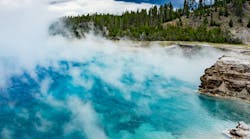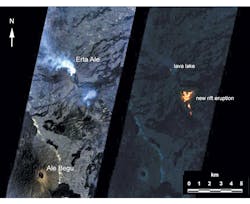It sounds like the plot of a disaster movie, only the approach will take years to have any effect. In case you haven’t heard yet about NASA’s either incredibly brilliant or amazingly outlandish plan to protect us from the supervolcano in Yellowstone National Park (and potentially the other 20 or so supervolcanoes on Earth), it is basically the highly complicated equivalent of adding a bit of cold water to a hot bath to cool it down.
According to an article on the BBC website, NASA’s idea centers around extracting some of the heat from the volcano to prevent its eruption: “They believe the most viable solution could be to drill up to 10 km down into the supervolcano, and pump down water at high pressure. The circulating water would return at a temperature of around 350°C (662°F), thus slowly day by day extracting heat from the volcano. And while such a project would come at an estimated cost of around $3.46 billion, it comes with an enticing catch which could convince politicians to make the investment.” The “catch” is that this drilling approach could be used to create a geothermal plant, which could generate electric power at prices of roughly $0.10/kWh.
Of course, drilling into a high-pressure supervolcano has obvious risks—the biggest being the possibility of accidentally triggering an eruption instead of preventing it. This is why the scientists are thinking that they should drill from the lower sides rather than the top, which would allow the heat to be removed before it reaches the top of the chamber. According to estimates, this approach would result in cooling the Yellowstone volcano only 1 meter per year, which means this project would take thousands of years.
There are many questions to be answered before such a plan would be agreed upon and set in motion. Clearly, the decision-makers should utilize all of the data and information so far obtained by NASA as well as other agencies and organizations (such as the U.S. Geological Survey, or USGS). They have been leveraging technologies ranging from radar to robots and artificial intelligence (AI) to monitor and investigate volcanoes. NASA’s Earth Observing 1 (EO-1) satellite, for example, was equipped with AI software that would prompt it to inform researchers when events of scientific interest took place and direct the spacecraft to take photos during passes.
According to the NASA website, the AI software—dubbed Autonomous Sciencecraft Experiment (ASE)—guided the actions of EO-1 for more than 12 years (concluding this past spring when EO-1’s mission ended). Additionally, it managed a “sensor web” comprising both satellites and ground sensors to help decide which events were a priority. Given the ongoing efforts of satellites, ground sensors, radar, and more to obtain data on volcanoes, a supersized version of this AI software may be able to guide the fact-finding needed as plans are discussed around supervolcanoes. As far-fetched as this plan may sound, it could eradicate a threat to millions of lives. NASA’s scientists are hoping that their blueprints will encourage practical scientific discussion and debate for tackling the threat.


